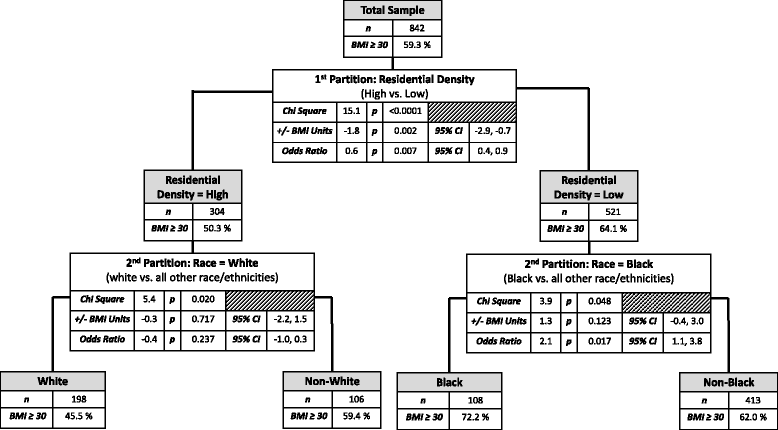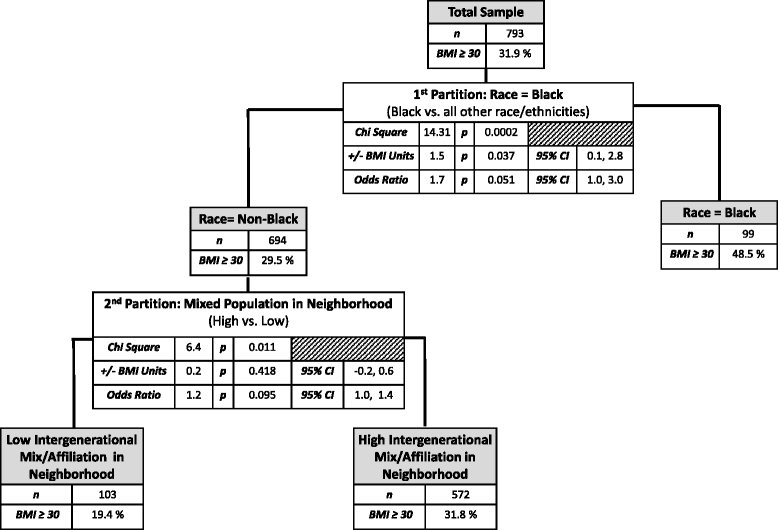An observational study identifying obese subgroups among older adults at increased risk of mobility disability: do perceptions of the neighborhood environment matter?
- PMID: 26684894
- PMCID: PMC4683911
- DOI: 10.1186/s12966-015-0322-1
An observational study identifying obese subgroups among older adults at increased risk of mobility disability: do perceptions of the neighborhood environment matter?
Abstract
Background: Obesity is an increasingly prevalent condition among older adults, yet relatively little is known about how built environment variables may be associated with obesity in older age groups. This is particularly the case for more vulnerable older adults already showing functional limitations associated with subsequent disability.
Methods: The Lifestyle Interventions and Independence for Elders (LIFE) trial dataset (n = 1600) was used to explore the associations between perceived built environment variables and baseline obesity levels. Age-stratified recursive partitioning methods were applied to identify distinct subgroups with varying obesity prevalence.
Results: Among participants aged 70-78 years, four distinct subgroups, defined by combinations of perceived environment and race-ethnicity variables, were identified. The subgroups with the lowest obesity prevalence (45.5-59.4%) consisted of participants who reported living in neighborhoods with higher residential density. Among participants aged 79-89 years, the subgroup (of three distinct subgroups identified) with the lowest obesity prevalence (19.4%) consisted of non-African American/Black participants who reported living in neighborhoods with friends or acquaintances similar in demographic characteristics to themselves. Overall support for the partitioned subgroupings was obtained using mixed model regression analysis.
Conclusions: The results suggest that, in combination with race/ethnicity, features of the perceived neighborhood built and social environments differentiated distinct groups of vulnerable older adults from different age strata that differed in obesity prevalence. Pending further verification, the results may help to inform subsequent targeting of such subgroups for further investigation.
Trial registration: Clinicaltrials.gov Identifier = NCT01072500.
Figures
References
-
- World Health Organization . Global strategy on diet, physical activity, and health. Geneva: WHO; 2004.
-
- World Health Organization . Country profiles on nutrition, physical activity, and obesity in the 53 WHO European Region Member States: Methodology and summary. Copenhagen, Denmark: World Health Organization; 2013.
Publication types
MeSH terms
Associated data
Grants and funding
- K07AG043587/AG/NIA NIH HHS/United States
- K07 AG043587/AG/NIA NIH HHS/United States
- P30 AG024827/AG/NIA NIH HHS/United States
- P30 AG031679/AG/NIA NIH HHS/United States
- U01 AG22376/AG/NIA NIH HHS/United States
- 3U01AG022376-05A2S/AG/NIA NIH HHS/United States
- P30 AG028740/AG/NIA NIH HHS/United States
- P30 AG021342/AG/NIA NIH HHS/United States
- Intramural NIH HHS/United States
- 1R24HD065688-01A1/HD/NICHD NIH HHS/United States
- P30AG021342/AG/NIA NIH HHS/United States
- UL1 RR025744/RR/NCRR NIH HHS/United States
- UL1 TR000142/TR/NCATS NIH HHS/United States
- UL1 TR001085/TR/NCATS NIH HHS/United States
- R24 HD065688/HD/NICHD NIH HHS/United States
- U54RR025208/RR/NCRR NIH HHS/United States
- 1 P30 AG21332/AG/NIA NIH HHS/United States
- U01 AG022376/AG/NIA NIH HHS/United States
- 1P30AG031679/AG/NIA NIH HHS/United States
- 1 P30 AG028740/AG/NIA NIH HHS/United States
- P30 AG021332/AG/NIA NIH HHS/United States
LinkOut - more resources
Full Text Sources
Other Literature Sources
Medical



